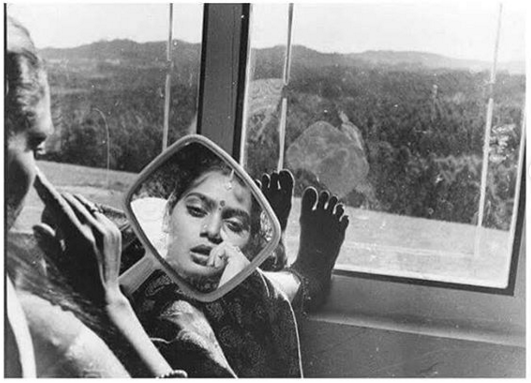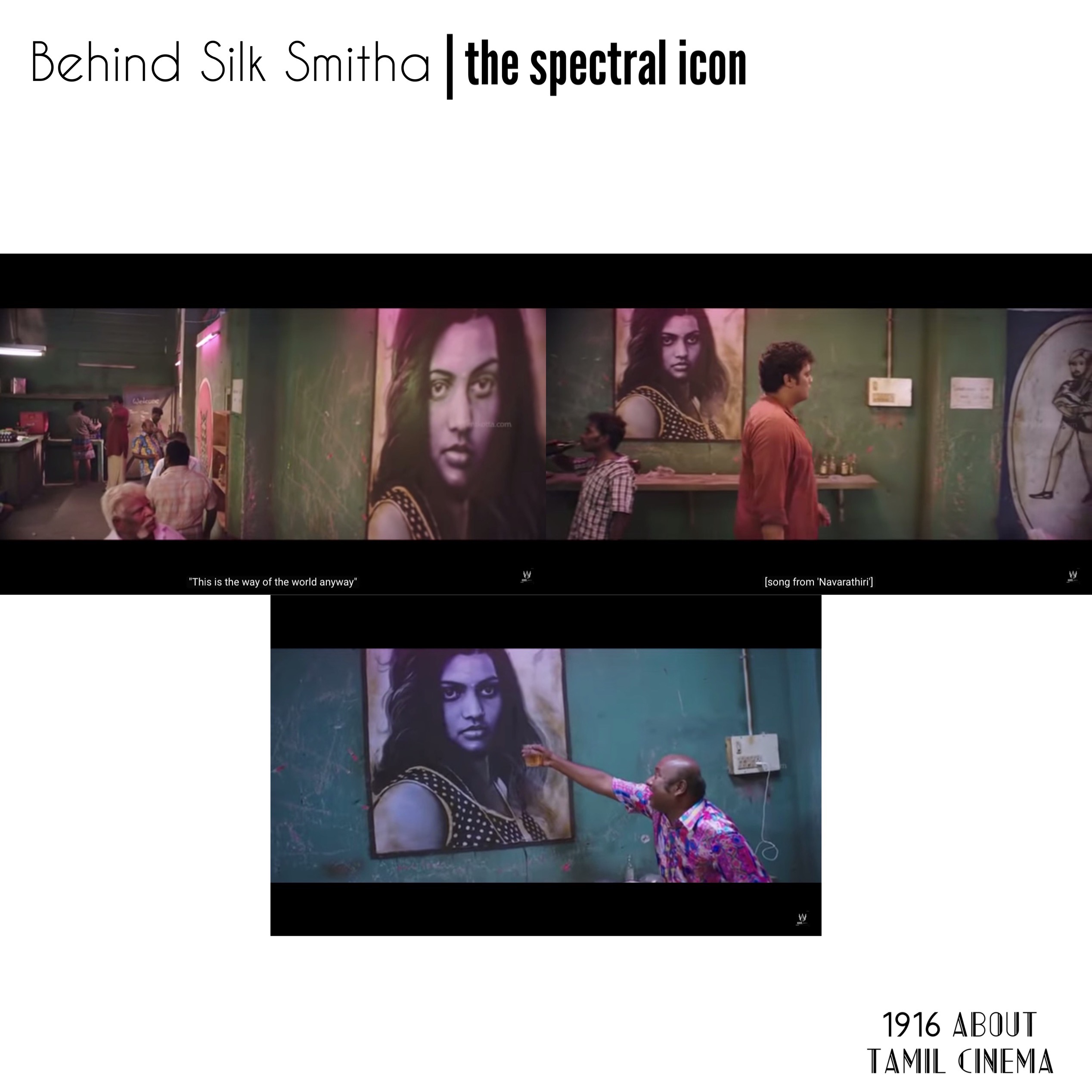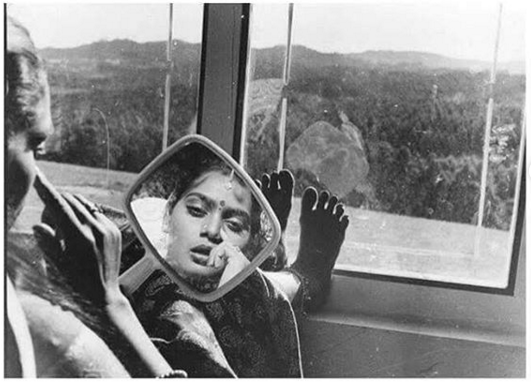I grew up with the idea that Silk Smitha was the incarnation of all the taboos my tamil family didn’t want to talk about : sexuality, sensuality, women’s bodies, gender inequalities. I guess she was the very antithesis of the woman I was meant to become. Then, as always when it comes to humans of tamil cinema and especially with iconic figures, my mind started asking questions : how the actress became an icon ? what is the story behind her ? And sadly, as often when it comes to 1970s-1980s actresses, I understood that the story has nothing to envy to the darkest tragedies : remember this « suicide sisterhood » of south indian actresses who, from the 1970s, ended their lives at a very young age, like Vijayshree, Shobha, Fatafat Jayalxmi, Divya Bharti etc etc etc.
So, behind Silk Smitha, there is Vijayalakshmi Vadlapati (her real name). Born in 1960, this girl from a poor family in a small village of Andhra Pradesh stopped school at 10. She was married when she was only a teenager and suffered ill-treatment by her husband and in-laws. To escape this hell of a life, Vijayalakshmi had no other choice but run away. That‘s how she went to Madras and decided to enter the film industry. She began as a touch-up artist, then got some small roles, then met Vinu Chakravarthy who gave her the role of « Silk » in his movie, Vandichakkaram, in 1979. Thus, Vijayalakshmi became « Silk Smitha », a new identity that stuck to her skin for 16 years of career, for more than 450 films in all indian film industries, until one day in 1996, she decided to end her life at the age of 35…
The more I read about Silk Smitha, the more I see her as a victim of contradictory film industry which had both created her as a sexual icon and insulted her for this. Indeed, she pleased voyeuristic heterosexual male gaze as well as she disturbed the patriarchal film industry : a woman who seems to be so confortable with her sensuality was obviously too rebellious, a woman who was bold in her life choices despite the gossips was obviously too threathening, a woman who was typecasted as a pleasurable object in most of her films but knew how to use it as a powerful weapon was obviously a dangerous witch for them. Film historian, Randor Guy, a friend of Silk Smitha, says that « films that lain in cans for years were sold by the simple addition of Silk Smitha song ». And indeed, theaters were mostly frequented by male audience and the simple presence of Silk Smitha was an insurance to sell tickets.
Despite this power (or because of it), Silk Smitha was oppressed in a patriarchal film industry (from producers to actors) which led her to death. This is the life arc of so many icons like Marilyn Monroe or Meena Kumari, creatures of an entertainment industry which imprisoned them in a celluloid image. Strangely, in a TV series written by Randor Guy, Silk Smitha played a role where she is found dead in a bathtub…just like a tribute to Marilyn’s last breath and a premonition of Silk Smitha’s. Through her 35 years of existence, a lot has been stolen from her : her childhood, her freedom, her identity. Her story is the one of a girl who always had to run away, from her family, from the industry, from life. And, in fact, I’ve always felt this melancholy of hers in every frame she acted : even in the most glittering dance sequence, she always seems detached, just like her real self extracts from her body to judge her screen persona. For me, in this scene of Sadma (hindi remake of Moondram Pirai), Balu Mahendra captured the truth of Silk Smitha : a floating sorrow, a deep loneliness, a girl who dreams of another life for herself…

As many stars, Silk Smitha couldn’t escape the image trap. Despite the acting talent she showed in some of her few well written roles (in Balu Mahendra’s Moondram Pirai or Bharathi Raja’s Alaigal Oyvathillai), she was labelled, during her whole career, as the sexy vamp who sensationalize the screen with her dance numbers, her glittering and uncovering costumes (designed by herself most of the time) and usually, with a poor characterization which asked her nothing more than being a pleasurable object.
Behind this celluloid image, there was a very codified representation of women in 1970s and 1980s films. Indeed, since the nascent Tamil cinema, there was a dichotomy between the immoral and dangerous woman, on the one hand, and the virtuous and chaste woman, on the other. Think about Kannagi and Madhavi in Silappathikaram or about Vimala, the educated and pure heroine opposed to the sneaky dancer who steals money from Gunasekaran in Parasakthi. In fact, this « madonna and the whore » thing also existed in western imaginary, from the biblical opposition between the Virigin Mary and Mary Magdalene to Hollywood classics. But in Tamil cinema, this dichotomy has always been rooted in the social class/caste of the character (and the actress). If Vijayalakshmi Vadlapati became Silk Smitha, it’s also because she was a dark-skinned girl from a lower class/caste who entered a film industry where the « respectable » female characters were supposed to be fair, upper-class/caste women. In fact, in many films, through make-up or lighting, Silk Smitha’s dark skin wasn’t hidden but instead highlighted to underline the fact that only a dark-skinned, lower caste/class woman, could be such a sensual, sexually liberated and deviant femme fatale…
Indeed, Dalit-bahujan women bodies were as desired as there were despised, there were shown as public object of pleasure, whereas upper-class/caste women bodies were the precious incarnation of chastity and « karpu », there were « only for the pleasure of the husband and that too within the setting of a private space », as Sathiavathi Chinniah wrote in her article about Tamil film heroine. Thus, Dalit-bahujan ladies were allowed to fall in depravity whereas upper-class/caste ladies were supposed to be the guardians of purity and family honor. Interestingly, for a long period in American and European cinema, black actresses were cantoned as well, as sexual objects meant for the white male gaze and desire, thus reflecting omnipresent colonial and racist fantasies.
Off screen, despite the image of a powerful woman who owns her sexuality, despite Silk Smitha’s attempts to emancipate herself, to live her life as she wished, the real power and agency remained in the hands of men in a patriarchal and casteist film industry. Indeed, harsh behavior on sets, harassment and violence against dalit women in film industry were legitimized by their supposed immorality…Silk Smitha didn’t escape the rule, thus being more a victim of the film industry than an ambitious vamp who experienced a rise and a fall, as depicted, for example, in The Dirty Picture, movie which appeared very superficial and pretty reductive to me, regarding the depth of her real story, the one of a young dalit girl who fought to make herself a better place in a hostile context until one day, exhausted, she decided to end her life.
And that’s it. Behind the name of « Silk Smitha », there is this sad story of the exploitation of a young dalit woman. Behind the name of « Silk Smitha », there are a few victorious battles but above all, behind the name of « Silk Smitha », there is a lost war against patriarchy and casteism in film industry…


In these scenes of Kathalum Kadanthu Pogum and Silukuvarpatti Singam, on the walls of a shabby club, behind a bunch of drunk and lonely men, Silk Smitha appears as a ghostly image. In this high place of male sociability and a recurrent topos in Tamil cinema, these big size photographs turn her into an « icon », « eikon » in ancient Greek, literaly a religious image which was usually a painting in the early years of Christianity. In other words, under the dim light of these male-dominated clubs and more generally, in our contemporary imaginary, Silk Smitha has become a venerated and hyper-sexualized goddess. Thus, Silk Smitha is no longer the whore opposed to the immaculate heroine, she is no longer « real » as she has been frozen into a (sex-)symbol, into a « modern myth », as defined by Roland Barthes, that is to say « a communication system, a message » which abolishes the complexity of human acts to give the simplicity of essence, reflecting contemporary values system and the ideology of the dominant groups.
So, what is this « iconic » Silk Smitha, the name of ? On the one hand, deification is never a good sign for the feminine gender because it is the culmination of the passive woman, frozen and dispossessed of her destiny : just take a look at Satyajit Ray’s Devi (1960). On the other hand, each portrait of Silk Smitha in these club scenes also appears to me, as by a boomrang effect, like a mirror that sends back to the fantasies of those who look at it with desire and reduce her as a « pleasurable object ». Indeed, this Silk Smitha hanging on the wall seems to be a judging goddess who looks scornfully at the flawed and grotesque masculinity shown in these scenes. Somehow, directors Nalan Kumarasamy and Chella judiciously chose these ghostly images of the 1980s sex-symbol to highlight the fact that those men still live in a past-time masculinity which is now clearly entering a post-modern crisis (see almost all Vijay Sethupathi films and their derivative). Somehow, Silk Smitha has become a spectral, mythified, irradiant icon who is the object of the famous « male gaze » as well as the best weapon to question and destroy it. In other words, even after death, she is a bomb. Above all, even though she has become a phantom image, appropriated by our contemporary imaginary, the real Silk Smitha, that is to say Vijayalakshmi Vadlapati, will forever be a mystery that escapes us.
Shakila Z.
Post scriptum : here are some interesting contemporary art works found on Instagram, that show, how “iconic” Silk Smitha has become an obsession.











